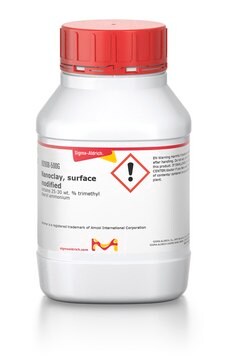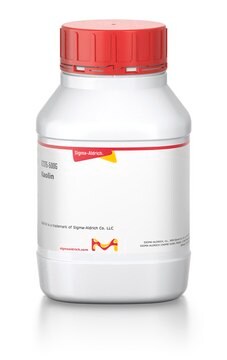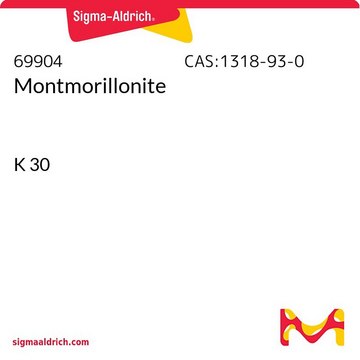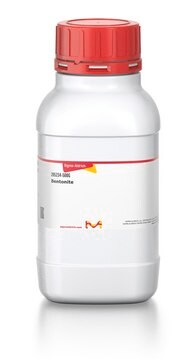All Photos(4)
About This Item
Linear Formula:
Al2Si2O5(OH)4 · 2 H2O
CAS Number:
Molecular Weight:
294.19
EC Number:
MDL number:
UNSPSC Code:
12162002
PubChem Substance ID:
NACRES:
NA.23
Recommended Products
form
nanopowder
Quality Level
diam. × L
30-70 nm × 1-3 μm , nanotube
surface area
64 m2/g
color
75-96, Hunter Brightness
refractive index
n20/D 1.54
pore size
1.26-1.34 mL/g pore volume
capacity
8.0 meq/g cation exchange capacity
density
2.53 (true specific gravity)
SMILES string
O.O.O[Si](O)(O[Al]=O)O[Si](O)(O)O[Al]=O
InChI
1S/2Al.H4O7Si2.2H2O.2O/c;;1-8(2,3)7-9(4,5)6;;;;/h;;1-2,4-5H;2*1H2;;/q2*+1;-2;;;;
InChI key
HEFIDAICLOZRRO-UHFFFAOYSA-N
General description
Halloysite nanoclay has a tube like morphology. It shows low electrical, thermal conductivity and strong hydrogen interactions, on account of which the inner hydroxyl groups show greater stability than the surface hydroxyl groups in halloysite. The loss of hole water occurs at nearly 300 °C.
Similar to montmorillonite, halloysite consists of two layers of aluminosilicate in 1:1 Al:Si ratio. Significant improvements in thermal, mechanical properties have been reported on addition of halloysite nanotubes in polymer composites.
Similar to montmorillonite, halloysite consists of two layers of aluminosilicate in 1:1 Al:Si ratio. Significant improvements in thermal, mechanical properties have been reported on addition of halloysite nanotubes in polymer composites.
Application
Halloysite is frequently used as a reinforcement in various nanocomposites, some of which are listed here:
Isotactic propylene-halloysite nanocomposites.
Alloy composites by electroless/ autocatalytic deposition.
Poly(butylene terephthalate) (PBT) composites.
Zinc–halloysite nanotube (HNT) composite coatings.
Halloysite nanotube–hydroxyapatite–hyaluronic acid films.
Halloysite combined with polyamide, polypropylene, poly(ε-caprolactone) and fluroelastomers.
Its tube like morphology, high aspect ratio, and low percolation enables interesting applications as reinforcements in nanocomposites.
Isotactic propylene-halloysite nanocomposites.
Alloy composites by electroless/ autocatalytic deposition.
Poly(butylene terephthalate) (PBT) composites.
Zinc–halloysite nanotube (HNT) composite coatings.
Halloysite nanotube–hydroxyapatite–hyaluronic acid films.
Halloysite combined with polyamide, polypropylene, poly(ε-caprolactone) and fluroelastomers.
Its tube like morphology, high aspect ratio, and low percolation enables interesting applications as reinforcements in nanocomposites.
Legal Information
Product of Applied Minerals, Inc. Customers may obtain additional technical support and purchase commercial quantities at appliedminerals.com
Storage Class Code
11 - Combustible Solids
WGK
nwg
Flash Point(F)
Not applicable
Flash Point(C)
Not applicable
Personal Protective Equipment
dust mask type N95 (US), Eyeshields, Gloves
Choose from one of the most recent versions:
Already Own This Product?
Find documentation for the products that you have recently purchased in the Document Library.
Customers Also Viewed
Effects of filler type on the nonisothermal crystallization kinetics of poly(butylene terephthalate) (PBT) composites
Oburo?lu N, et al.
Journal of Applied Polymer Science, 123(1), 77-91 (2012)
Joussein E. et al.
Clay Minerals, 40, 383-383 (2005)
Electrophoretic deposition of composite halloysite nanotube?hydroxyapatite?hyaluronic acid films
Deen I and Zhitomirsky I
J. Alloy Compounds, 586(1), S531-S534 (2014)
Vladimir Vinokurov et al.
Polymers, 11(5) (2019-05-30)
Silica gels are widely employed in water shutoff services, making them an essential tool in oil well management. Silica nanoparticles may serve as a strengthening additive for polymer hydrogels. In this study, we look at this statement from a different
S R Levis et al.
International journal of pharmaceutics, 243(1-2), 125-134 (2002-08-15)
Halloysite supplied from New Zealand was shown by electron microscopy to be composed mainly of hollow microtubules having typical dimensions of 2-3 microm long and 0.3/0.1 microm outer/inner diameter. Aggregates of microtubules, double tubules and occasional split or partially unrolled
Our team of scientists has experience in all areas of research including Life Science, Material Science, Chemical Synthesis, Chromatography, Analytical and many others.
Contact Technical Service













